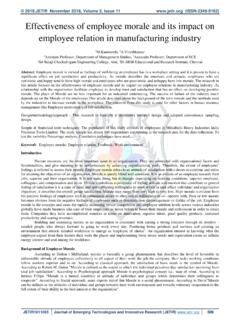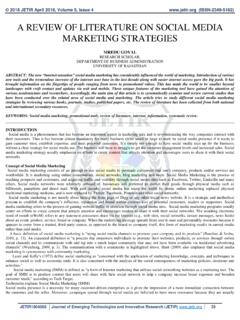Transcription of QUALITATIVE AND QUANTITATIVE PHYTOCHEMICAL …
1 2019 JETIR December 2019, Volume 6, Issue 12 (ISSN-2349-5162). QUALITATIVE AND QUANTITATIVE . PHYTOCHEMICAL analysis OF. Lantana camara LEAF EXTRACT. A. Poongothai *. Assistant Professor, PG and Research Department of Biochemistry, Sacred Heart College (Autonomous), Tirupattur - 635 601. Tirupattur District, Tamil Nadu, India. Abstract In the present study, the PHYTOCHEMICAL screening of the powder of leaf of Lantana Camara methanolic extract was executed. The results of QUALITATIVE PHYTOCHEMICAL screening of methanolic extract of Lanatana camara leaves revealed that the presence of various bioactive secondary metabolites constituents in alkaloids, flavonoids, phenols, tannins, saponins, carbohydrates, amino acids, steroids, terpenoids and protein were respectively.
2 The QUANTITATIVE PHYTOCHEMICAL analysis of methanolic extract of Lanatana camara leaves showed that the maximum concentration of flavonoids ( ) followed by Alkaloids ( ). Phenol ( ) and Tannins ( ) were respectively. Hence, Lanatana camara are used for discovering and analysis of the Secondary metabolites which are precise helpful for the manufacturing of new drugs for treatment of various diseases. Key words: Lanatana camara, QUALITATIVE and QUANTITATIVE PHYTOCHEMICAL screening. 1. INTRODUCTION. Plants constitute a source of different chemical compounds which are possible to use in medicine and other applications. The plant parts such as leaves, flowers, bark, seeds, fruits, stem and root contain the following bioactive compound like alkaloids, steroids, tannins, glycosides, volatile oils, fixed oils, resins, phenols and flavonoids.
3 Owing to the significance in the above context, such preliminary PHYTOCHEMICAL screening of plants is the need of the hour in order to discover and develop novel therapeutic agents with improved efficacy. Numerous research groups have also reported such studies throughout the world. There is a growing awareness in connecting the PHYTOCHEMICAL constituents of a medicinal plant with its pharmacological activity. Screening of active compounds from plants has led to the invention of new medicinal drugs which has efficient protection and used for the treatment of various diseases. Nowadays natural products derived from plants are being tested for presence of novel drugs with new modes of pharmacological action [1]. Phytochemicals are the natural bioactive compounds.
4 That are naturally present in plants and the most considerable bioactive components of plants are alkaloids, tannins, flavonoids, steroids, terpenoids, carbohydrates and phenolic compounds. Plants have been used as a substitute medicine to promote human health and endurance in many regions of the world since prehistoric times. Plants are the great sources of medicines, especially in traditional system of medicine, which are useful in the treatment of various diseases. Lantana camara Linn. (Family Verbenaceae) is rugged evergreen shrub growing to m high and available throughout central and south India in most dry stony hills and black soil. The leaves of the plant are boiled for tea and the decoction is a remedy against cough. The decoction of the whole plant is given as treatment against tetanus, rheumatism, malaria and ataxia of abdominal viscera.
5 It is used as a lotion for wounds. Pounded leaves are applied to cuts, ulcers and swellings [2]. In the present study to evaluate the QUALITATIVE and QUANTITATIVE preliminary PHYTOCHEMICAL analysis of methanolic extract of Lantana camara leaves. 2. Materials and Methods Plant authentication and Extract preparation Lantana Camara leaves were collected from koodapattu, Tirupattur (Dist), Tamil Nadu, South India. The plant was identified and (Reg. no of Certificate no: 4133) Institute of Herbal Botany, Plant Anatomy Research Centre, Presidency college, Chennai. The 10g of Lantana Camara leaves powder and 100 ml of methanol using Soxhlet apparatus. Extraction was considered to be completed when the Leaves materials become exhausted of their constituents that were confirmed.
6 The filtrates obtained are dried at temperature of 40 2 C to have gummy concentrate of the crude extract. The extract is kept in a suitable container with proper labeling and then stored in cold and dry place for further use. JETIR1908558 Journal of Emerging Technologies and Innovative Research (JETIR) 603. 2019 JETIR December 2019, Volume 6, Issue 12 (ISSN-2349-5162). Plate 1: Lantana Camara leaves 3. QUALITATIVE analysis OF PHYTOCHEMICALS. The QUALITATIVE PHYTOCHEMICAL analysis of methanolic extract of Lantana Camara leaves was carried out as per standard methods described by [3]. Detection of Alkaloids: Mayer's test: The extract was treated with Mayer s reagent. Formation of a yellow cream precipitate indicates the presence of alkaloids.
7 Wagner s test: The extract was treated with Wagner s reagent. Formation of brown/reddish brown precipitate indicates the presence of alkaloids. Detection of Flavonoids: Lead acetate test: Extracts were treated with few drops of lead acetate solution. Formation of yellow color precipitate indicates the presence of flavonoids. Sulphuric acid test: Extracts were treated with few drops of H2SO4. Formation of orange colour indicates the presence of flavonoids. Detection of Steroids: Two ml of acetic anhydride was added to five ml of the extract and then added each with two ml of H2SO4. The color was changed from violet to blue or green indicates the presence of steroids Detection of Terpenoids: Salkowski s Test: Five ml of the extract mixed with two ml of chloroform and then added carefully the 3 ml of concentrated H2SO4 to form a layer.
8 An appearance of reddish brown colour in the inner face indicates the presence of terpenoids. Detection of Phenols: Ferric chloride test: 10ml of the extract was treated with few drops of ferric chloride solution. Formation of bluish black colour indicates the presence of phenol. Lead acetate test: 10 ml of the extract was treated with few drops of lead acetate solution. Formation of yellow colour precipitate indicates the presence of phenol. Detection of Saponins: About of the extracts was shaken with five ml of distilled water. Formation of frothing (appearance of creamy of small bubbles) shows the presence of saponins. Detection of Tannins: A small quantity of extract was mixed with water and heated on a water bath. The mixture was filtered and ferric chloride was added to the filtrate.
9 A dark green colour was formed. It indicates the presence of tannins. Detection of Carbohydrates: extracts were dissolved individually in five ml distilled water and filtered. The filtrate was used to test the presence of carbohydrates. JETIR1908558 Journal of Emerging Technologies and Innovative Research (JETIR) 604. 2019 JETIR December 2019, Volume 6, Issue 12 (ISSN-2349-5162). Detection of Protein & Amino acids Biuret test: To ml of extract equal volume of 40% NaOH solution and two drops of one percent copper sulphate solution was added. The appearance of violet colour indicates the presence of protein. Ninhydrin test: About ml of extract was taken and two drops of freshly prepared Ninhydrin reagent was added and heated. The appearance of pink or purple colour indicates that the presence of proteins, peptides or amino acids.
10 4. QUANTITATE PHYTOCHEMIAL analysis . The QUANTITATIVE PHYTOCHEMICAL analysis of methanolic extract of Lantana camara leaves was carried out. Determination of Total Flavonoids The TFC in the sample was estimated by the method of Chang et al. [4] One ml of the extracts and standard solutions of quercetin was added to a 10 ml containing four ml of distilled water and added ml of 5% sodium nitrite after 5 min and ml of 10% Aluminum chloride was added. Again added 2 ml of 1M. sodium hydroxide finally made up to 10 ml of distilled water. The solution absorbance was measured at 510. nm and results expressed as mg quercetin equivalent/g dry weight plant material. Determination of Total Alkaloids Alkaloid was determined using Harborne method. 5 g plant extract, 10 ml of 10% acetic acid in ethanol was added and allowed to stand for 4 hrs after that sample will be filtered.




